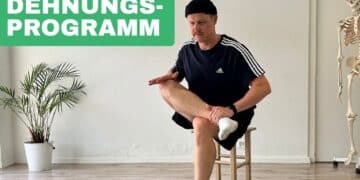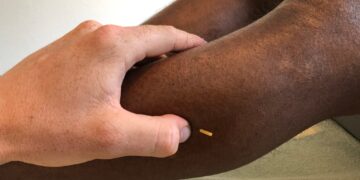The road back to fitness after an ankle sprain
The way back to sport after an ankle sprain
Whether you're playing an intense game of basketball, jogging on uneven ground, on the badminton or tennis court - one wrong step and your ankle is sprained. Such moments often happen faster than you can say "ouch". But don't worry! In many cases, only the anterior, outer collateral ligament is affected and recovery is usually quick and positive.
After the ankle injury
The first step after an ankle sprain
A twisted or twisted foot can be very painful. However, with the right follow-up treatment, you can get back on your feet quickly. Did you know that 70% of those affected who do not receive appropriate treatment often suffer re-injuries? That is why it is essential to act quickly.
Your support from physiotherapy
Our physiotherapy aims to get you back to your everyday life safely and quickly. We also want to ensure that you are soon active again and prevent future injuries and chronic instabilities. This is because persistent instabilities increase the risk of Osteoarthritis in the ankle joint.
Our therapeutic approach is individually adapted to your healing phases. In the initial phase, we offer you strategies for everyday life to avoid strain. In the following sessions, we increase the load in a controlled manner - the training begins! As a rule, after 4-8 weeks (or 8-12 weeks in the case of more serious injuries) you will reach the same level of function as before the injury.
What exactly is an ankle sprain?
An ankle sprain, also known as an ankle sprain, can have varying degrees of severity, from a strain of the ligaments and muscles to a complete tear. In 93% of cases, the anterior, outer collateral ligament tears. With the right follow-up treatment, those affected often have a good chance of making a full recovery. However, particularly severe cases in which the posterior outer ligament or other structures are also affected may require longer rehabilitation periods.
What to do in the event of an ankle sprain?
The PECH rule used to be recommended: Rest, ice, compression and elevation. Nowadays, however, the most modern treatment is based on the PEACE and LOVE principle:
- Protection: Avoid painful movements in the first few days after the injury.
- Elevation: Raise the leg as often as possible, ideally above heart level.
- Avoid anti-inflammatories: Avoid anti-inflammatory drugs, as they can slow down the healing process.
- Compression: Use compression bandages or tapes to reduce swelling.
- Education: Well-informed patients heal faster. We attach great importance to informing you.
- Load: Later in the healing process, it is important to increase the load in a targeted manner, always in harmony with your pain sensation.
- Optimism: A positive attitude promotes the healing process.
- Vascularization: Pain-free activities such as cycling or swimming support healing.
- Exercise: Physiotherapy helps you to regain strength and mobility through targeted exercises.
Conservative therapy versus surgery
In most cases, conservative therapy has advantages over surgery - shorter rehabilitation times and fewer complications are just some of them. Surgery is usually only necessary in cases of severe trauma (grade 3) or additional bone fractures. Studies show that even after severe injuries (grade 3), patients treated with physiotherapy recover just as well as after surgery.
Walking the path to recovery together
Let us work together on your recovery! Trust our expertise and our tried and tested treatment methods. Whether you're a jogger, recreational badminton player or tennis enthusiast - we'll help you get back to your favorite sport soon, pain-free and full of energy.
Your path back to mobility starts here!
Your motivational guide after an ankle sprain
An ankle sprain is not the end, but the beginning of a new, challenging chapter. Whether you've been injured while running, on the badminton or tennis court, or during another sporting activity, the good news is that you can come back stronger than ever. The journey of recovery may be tough, but each stage along the way brings you closer to your comeback.
The first stage is to accept the injury and prepare yourself mentally. The ankle sprain is your new challenge, and with the right attitude you can overcome it. Every small improvement is a step in the right direction.
Patience and continuity are crucial. Sporting success does not happen overnight and the same applies to healing an ankle sprain. Follow your rehabilitation plan with discipline and consistency. The road back to your normal activities starts here and now.
Our physiotherapy is not only focused on your physical recovery, but also on giving you mental support. Through targeted exercises and individual support, every session becomes an opportunity to get closer to your sporting comeback.
Use the rehabilitation period to build an even stronger foundation. Strengthen your weak points and improve your overall fitness to not only return to your previous level of performance, but even surpass it.
Let your family, friends and team motivate and support you. The shared joy of progress and shared strength are invaluable assets on your journey of recovery and return to sport.
An ankle sprain may be challenging, but remember: your comeback starts today. Trust in your body, your mental strength and the support of those around you. Together we can do it!
Categories
- Osteoarthritis
- Leg
- Extensions
- Dry needling
- Elbow
- Foot
- Balance
- Hand
- Hip
- Pine
- Knee
- Headache
- Lymphatic drainage
- Mobilization
- Muscle pain
- Myofascial therapy
- Neck pain
- Physiotherapy Höngg
- Physiotherapy Wipkingen
- Physiotherapy Zurich
- Rehabilitation
- Back pain
- Shoulder arm
- Shoulder pain
- Pregnancy
- Dizziness
- Sports
- Trigger points
- Exercises
- Lower leg
- Injury prevention
- Wade
- What to do?
- Wound healing
Sprained foot
Holistic treatment of ankle sprains: Effectively counteracting sprains of the foot Ankle sprains,...
Read moreStretching program
Your stretching program Stretching is an essential foundation for your mobility and well-being....
Read moreAnkle sprain - causes, treatment & tips for recovery
The way back to sport after an ankle sprain Whether during an intensive game of basketball, jogging on uneven ground or...
Read moreAchilles pain? These methods really help
Achilles tendon pain: causes, symptoms and treatment options What is Achilles tendon pain? The Achilles tendon...
Read moreFlossing for scar treatment: Innovative, effective and supportive
Have you ever heard of flossing? This innovative physiotherapy technique is becoming increasingly popular,...
Read moreDry needling explained: when and why it helps
Discover the revolution in pain treatment: Dry Needling Imagine being able to treat chronic pain with...
Read more







